A Multi-Omics Analysis Revealed the Diversity of the MYB Transcription Factor Family’s Evolution and Drought Resistance Pathways
Abstract
1. Introduction
2. Materials and Methods
2.1. Materials
2.1.1. Genomic Data
2.1.2. Transcriptomic Data
2.2. Data Processing Methods
2.2.1. Construction of MYB Transcription Factor Family Database
Identification of MYB Family Members
Subfamily Division of MYB Members
Phylogenetic Analysis of Interspecies MYB Family
2.2.2. Analysis of Expression Modules of Interspecies MYB Family
Data Quality Control and Sequence Assembly
DEGs (Differential Expression Genes) of MYB Family Screening
DEG Function Analysis
3. Results
3.1. MYB Transcription Factor Family Database
3.1.1. MYB Family Members’ Distribution
3.1.2. Diversity of Evolutionary Trends among MYB Families
3.2. Interspecific MYB Family Expression Profile Diversity
3.2.1. Expression Profile of MYB Family in Arabidopsis thaliana
Expression of Arabidopsis thaliana MYB Family
Functional Annotation of DEGs in Arabidopsis thaliana MYB Family
Main Drought Resistance Pathways of Arabidopsis thaliana MYB Family
3.2.2. Expression Profiles of MYB Families in Gramineae Species
Expression Profile of MYB Family in Wheat (Triticum aestivum)
- I.
- Expression of Wheat (Triticum aestivum) MYB Family
- II.
- Functional Annotation of DEGs in Wheat (Triticum aestivum) MYB Family
- III.
- Main Drought Resistance Pathways of Wheat (Triticum aestivum) MYB Family
Expression Profile of MYB Family in Rice (Oryza sativa)
- I.
- Expression of Rice (Oryza sativa) MYB Family
- II.
- Functional Annotation of DEGs in Rice (Oryza sativa) MYB Family
- III.
- Main Drought Resistance Pathways of Rice (Oryza sativa) MYB Family
3.2.3. Expression Profile of MYB Family in Soybean (Glycine max)
Expression of Soybean (Glycine max) MYB Family
Functional Annotation of DEGs in Soybean (Glycine max) MYB Family
Main Drought Resistance Pathways of Soybean (Glycine max) MYB Family
3.2.4. Expression Profile of MYB Family in Potato (Solanum tuberosum)
Expression of Potato (Solanum tuberosum) MYB Family
Functional Annotation of DEGs in Potato (Solanum tuberosum) MYB Family
Main Drought Resistance Pathways of Potato (Solanum tuberosum) MYB Family
4. Discussion
4.1. Evolutionary Diversity of MYB Family
4.2. Diversity of Expression Profiles of MYB Family among Species under Drought Stress
5. Conclusions
Supplementary Materials
Author Contributions
Funding
Institutional Review Board Statement
Informed Consent Statement
Data Availability Statement
Acknowledgments
Conflicts of Interest
References
- Priya, M.; Dhanker, O.P.; Siddique, K.H.M.; HanumanthaRao, B.; Nair, R.M.; Pandey, S.; Singh, S.; Varshney, R.K.; Prasad, P.V.V.; Nayyar, H. Drought and heat stress-related proteins: An update about their functional relevance in imparting stress tolerance in agricultural crops. Theor. Appl. Genet. 2019, 132, 1607–1638. [Google Scholar] [CrossRef] [PubMed]
- Singhal, P.; Jan, A.T.; Azam, M.; Haq, Q.M.R. Plant abiotic stress: A prospective strategy of exploiting promoters as alternative to overcome the escalating burden. Front. Life Sci. 2015, 9, 52–63. [Google Scholar] [CrossRef]
- Oladosu, Y.; Rafii, M.Y.; Samuel, C.; Fatai, A.; Magaji, U.; Kareem, I.; Kamarudin, Z.S.; Muhammad, I.; Kolapo, K. Drought Resistance in Rice from Conventional to Molecular Breeding: A Review. Int. J. Mol. Sci. 2019, 20, 3519. [Google Scholar] [CrossRef] [PubMed]
- Vassileva, V.; Simova-Stoilova, L.; Demirevska, K.; Feller, U. Variety-specific response of wheat (Triticum aestivum L.) leaf mitochondria to drought stress. J. Plant Res. 2009, 122, 445–454. [Google Scholar] [CrossRef]
- Xu, Y.; Hu, W.; Liu, J.; Song, S.; Hou, X.; Jia, C.; Li, J.; Miao, H.; Wang, Z.; Tie, W.; et al. An aquaporin gene MaPIP2-7 is involved in tolerance to drought, cold and salt stresses in transgenic banana (Musa acuminata L.). Plant Physiol. Biochem. 2020, 147, 66–76. [Google Scholar] [CrossRef]
- Ding, L.; Gao, C.; Li, Y.; Li, Y.; Zhu, Y.; Xu, G.; Shen, Q.; Kaldenhoff, R.; Kai, L.; Guo, S. The enhanced drought tolerance of rice plants under ammonium is related to aquaporin (AQP). Plant Sci. 2015, 234, 14–21. [Google Scholar] [CrossRef]
- Poku, S.A.; Chukwurah, P.N.; Aung, H.H.; Nakamura, I. Over-Expression of a Melon Y3SK2-Type LEA Gene Confers Drought and Salt Tolerance in Transgenic Tobacco Plants. Plants 2020, 9, 1749. [Google Scholar] [CrossRef]
- Artur, M.A.S.; Zhao, T.; Ligterink, W.; Schranz, E.; Hilhorst, H.W.M. Dissecting the Genomic Diversification of Late Embryogenesis Abundant (LEA) Protein Gene Families in Plants. Genome Biol. Evol. 2019, 11, 459–471. [Google Scholar]
- Joshi, R.; Wani, S.H.; Singh, B.; Bohra, A.; Dar, Z.A.; Lone, A.A.; Pareek, A.; Singla-Pareek, S.L. Transcription Factors and Plants Response to Drought Stress: Current Understanding and Future Directions. Front. Plant Sci. 2016, 7, 1029. [Google Scholar]
- Khoso, M.; Hussain, A.; Ritonga, F.; Ali, Q.; Channa, M.; Alshegaihi, R.; Meng, Q.; Ali, M.; Zaman, W.; Brohi, R.; et al. WRKY transcription factors (TFs): Molecular switches to regulate drought, temperature, and salinity stresses in plants. Front. Plant Sci. 2022, 13, 1039329. [Google Scholar] [CrossRef]
- Riechmann, J.; Heard, J.; Martin, G.; Reuber, L.; Jiang, C.; Keddie, J.; Adam, L.; Pineda, O.; Ratcliffe, O.; Samaha, R.; et al. Arabidopsis transcription factors: Genome-wide comparative analysis among eukaryotes. Science 2000, 290, 2105–2110. [Google Scholar] [PubMed]
- Dubos, C.; Stracke, R.; Grotewold, E.; Weisshaar, B.; Martin, C.; Lepiniec, L. MYB transcription factors in Arabidopsis. Trends Plant Sci. 2010, 15, 573–581. [Google Scholar] [CrossRef]
- Ogata, K.; Kanei-Ishii, C.; Sasaki, M.; Hatanaka, H.; Nagadoi, A.; Enari, M.; Nakamura, H.; Nishimura, Y.; Ishii, S.; Sarai, A. The cavity in the hydrophobic core of Myb DNA-binding domain is reserved for DNA recognition and trans-activation. Nat. Struct. Mol. Biol. 1996, 3, 178–187. [Google Scholar]
- Ogata, K.; Morikawa, S.; Nakamura, H.; Hojo, H.; Yoshimura, S.; Zhang, R.; Aimoto, S.; Ametani, Y.; Hirata, Z.; Sarai, A.; et al. Comparison of the free and DNA-complexed forms of the DNA-binding domain from c-Myb. Nat. Struct. Biol. 1995, 2, 309–320. [Google Scholar]
- Du, H.; Zhang, L.; Liu, L.; Tang, X.-F.; Yang, W.-J.; Wu, Y.-M.; Huang, Y.-B.; Tang, Y.-X. Biochemical and molecular characterization of plant MYB transcription factor family. Biochemistry 2009, 74, 1–11. [Google Scholar] [CrossRef] [PubMed]
- Feller, A.; Machemer, K.; Braun, E.L.; Grotewold, E. Evolutionary and comparative analysis of MYB and bHLH plant transcription factors. Plant J. 2011, 66, 94–116. [Google Scholar]
- Nakabayashi, R.; Yonekura-Sakakibara, K.; Urano, K.; Suzuki, M.; Yamada, Y.; Nishizawa, T.; Matsuda, F.; Kojima, M.; Sakakibara, H.; Shinozaki, K.; et al. Enhancement of oxidative and drought tolerance in Arabidopsis by overaccumulation of antioxidant flavonoids. Plant J. Cell Mol. Biol. 2014, 77, 367–379. [Google Scholar]
- Wang, X.; Niu, Y.; Zheng, Y. Multiple Functions of MYB Transcription Factors in Abiotic Stress Responses. Int. J. Mol. Sci. 2021, 22, 6125–6149. [Google Scholar] [CrossRef]
- Zhu, N.; Duan, B.; Zheng, H.; Mu, R.; Zhao, Y.; Ke, L.; Sun, Y. An R2R3 MYB gene GhMYB3 functions in drought stress by negatively regulating stomata movement and ROS accumulation. Plant Physiol. Biochem. 2023, 197, 107648. [Google Scholar] [CrossRef]
- Li, H.; Yang, J.; Ma, R.; An, X.; Pan, F.; Zhang, S.; Fu, Y. Genome-wide identification and expression analysis of MYB gene family in Cajanus cajan and CcMYB107 improves plant drought tolerance. Physiol. Plant. 2023, 175, e13954. [Google Scholar] [CrossRef]
- Sun, M.; Xu, Q.; Zhu, Z.; Liu, P.; Yu, J.; Guo, Y.; Tang, S.; Yu, Z.; Xiong, A. AgMYB5, an MYB transcription factor from celery, enhanced β-carotene synthesis and promoted drought tolerance in transgenic Arabidopsis. BMC Plant Biol. 2023, 23, 151. [Google Scholar] [CrossRef] [PubMed]
- Wang, W.; Wang, L.; Wang, L.; Tan, M.; Ogutu, C.O.; Yin, Z.; Zhou, J.; Wang, J.; Wang, L. Transcriptome analysis and molecular mechanism of linseed (Linum usitatissimum L.) drought tolerance under repeated drought using single-molecule long-read sequencing. BMC Genom. 2021, 22, e109. [Google Scholar] [CrossRef]
- Mistry, J.; Finn, R.D.; Eddy, S.R.; Bateman, A.; Punta, M. Challenges in homology search: HMMER3 and convergent evolution of coiled-coil regions. Nucleic Acids Res. 2013, 41, e121. [Google Scholar]
- Yanhui, C.; Xiaoyuan, Y.; Kun, H.; Meihua, L.; Jigang, L.; Zhaofeng, G.; Zhiqiang, L.; Yunfei, Z.; Xiaoxiao, W.; Xiaoming, Q.; et al. The MYB transcription factor superfamily of Arabidopsis: Expression analysis and phylogenetic comparison with the rice MYB family. Plant Mol. Biol. 2006, 60, 107–124. [Google Scholar] [PubMed]
- Li, S.; Liu, J.; Xue, C.; Lin, Y.; Yan, Q.; Chen, J.; Wu, R.; Chen, X.; Yuan, X. Identification and Functional Characterization of WRKY, PHD and MYB Three Salt Stress Responsive Gene Families in Mungbean (Vigna radiata L.). Genes 2023, 14, 463. [Google Scholar]
- Du, H.; Wang, Y.B.; Xie, Y.; Liang, Z.; Jiang, S.J.; Zhang, S.S.; Huang, Y.B.; Tang, Y.X. Genome-Wide Identification and Evolutionary and Expression Analyses of MYB-Related Genes in Land Plants. DNA Res. 2013, 20, 437–448. [Google Scholar] [CrossRef] [PubMed]
- Emms, D.M.; Kelly, S. OrthoFinder: Solving fundamental biases in whole genome comparisons dramatically improves orthogroup inference accuracy. Genome Biol. 2015, 16, e157. [Google Scholar]
- Emms, D.M.; Kelly, S. OrthoFinder: Phylogenetic orthology inference for comparative genomics. Genome Biol. 2019, 20, e238. [Google Scholar]
- Tamura, K.; Stecher, G.; Kumar, S. MEGA11: Molecular Evolutionary Genetics Analysis Version 11. Mol. Biol. Evol. 2021, 38, 3022–3027. [Google Scholar] [CrossRef]
- Subramanian, B.; Gao, S.; Lercher, M.; Hu, S.; Chen, W. Evolview v3: A webserver for visualization, annotation, and management of phylogenetic trees. Nucleic Acids Res. 2019, 47, W270–W275. [Google Scholar] [CrossRef]
- Bolger, A.M.; Lohse, M.; Usadel, B. Trimmomatic: A flexible trimmer for Illumina sequence data. Bioinformatics 2014, 30, 2114–2120. [Google Scholar] [CrossRef] [PubMed]
- Du, Y.; Huang, Q.; Arisdakessian, C.; Garmire, L.X. Evaluation of STAR and Kallisto on Single Cell RNA-Seq Data Alignment. G3 2020, 10, 1775–1783. [Google Scholar] [CrossRef] [PubMed]
- Chen, C.; Chen, H.; Zhang, Y.; Thomas, H.; Frank, M.; He, Y.; Xia, R. TBtools: An Integrative Toolkit Developed for Interactive Analyses of Big Biological Data. Mol. Plant 2020, 13, 1194–1202. [Google Scholar] [CrossRef]
- Jaillon, O.; Aury, J.M.; Noel, B.; Policriti, A.; Clepet, C.; Casagrande, A.; Choisne, N.; Aubourg, S.; Vitulo, N.; Jubin, C.; et al. The grapevine genome sequence suggests ancestral hexaploidization in major angiosperm phyla. Nature 2007, 449, 463–467. [Google Scholar]
- Zheng, W.; Lu, Y.; Lin, S.; Wang, R.; Qiu, L.; Zhu, Y.; Yao, B.; Guo, F.; Jin, S.; Jin, L.; et al. A Novel Class of Natural FXR Modulators with a Unique Mode of Selective Co-regulator Assembly. Chembiochem A Eur. J. Chem. Biol. 2017, 18, 721–725. [Google Scholar] [CrossRef] [PubMed]
- Hata, K.; Takashima, R.; Amano, K.; Ono, K.; Nakanishi, M.; Yoshida, M.; Wakabayashi, M.; Matsuda, A.; Maeda, Y.; Suzuki, Y.; et al. Arid5b facilitates chondrogenesis by recruiting the histone demethylase Phf2 to Sox9-regulated genes. Nat. Commun. 2013, 4, 2850. [Google Scholar] [CrossRef] [PubMed]
- Alabadí, D.; Oyama, T.; Yanovsky, M.J.; Harmon, F.G.; Más, P.; Kay, S.A. Reciprocal regulation between TOC1 and LHY/CCA1 within the Arabidopsis circadian clock. Science 2001, 293, 880–883. [Google Scholar] [CrossRef]
- Kikis, E.A.; Khanna, R.; Quail, P.H. ELF4 is a phytochrome-regulated component of a negative-feedback loop involving the central oscillator components CCA1 and LHY. Plant J. 2005, 44, 300–313. [Google Scholar] [CrossRef]
- Hazen, S.P.; Schultz, T.F.; Pruneda-Paz, J.L.; Borevitz, J.O.; Ecker, J.R.; Kay, S.A. LUX ARRHYTHMO encodes a Myb domain protein essential for circadian rhythms. Proc. Natl. Acad. Sci. USA 2005, 102, 10387–10392. [Google Scholar] [CrossRef]
- Zhang, Y.; Xu, Y.; Xing, W.; Wu, B.; Huang, D.; Ma, F.; Zhan, R.; Sun, P.; Xu, Y.; Song, S. Passiflora edulisIdentification of the passion fruit (Sims) MYB family in fruit development and abiotic stress, and functional analysis of in abiotic stresses. Front. Plant Sci. 2023, 14, 1124351. [Google Scholar] [CrossRef]
- Zhou, Z.; Wei, X.; Lan, H. CgMYB1, an R2R3-MYB transcription factor, can alleviate abiotic stress in an annual halophyte Chenopodium glaucum. Plant Physiol. Biochem. 2023, 196, 484–496. [Google Scholar] [CrossRef] [PubMed]
- Si, Z.; Wang, L.; Ji, Z.; Zhao, M.; Zhang, K.; Qiao, Y. Comparative analysis of the MYB gene family in seven Ipomoea species. Front. Plant Sci. 2023, 14, e1155018. [Google Scholar] [CrossRef] [PubMed]
- You, C.; Dai, X.; Li, X.; Wang, L.; Chen, G.; Xiao, J.; Wu, C. Molecular characterization, expression pattern, and functional analysis of the OsIRL gene family encoding intracellular Ras-group-related LRR proteins in rice. Plant Mol. Biol. 2010, 74, 617–629. [Google Scholar] [CrossRef] [PubMed]
- Wang, L.; Jia, G.; Jiang, X.; Cao, S.; Chen, Z.J.; Song, Q. Altered chromatin architecture and gene expression during polyploidization and domestication of soybean. Plant Cell 2021, 33, 1430–1446. [Google Scholar] [PubMed]
- Yang, W.; Feng, L.; Luo, J.; Zhang, H.; Jiang, F.; He, Y.; Li, X.; Du, J.; Owusu Adjei, M.; Luan, A.; et al. Genome-Wide Identification and Characterization of R2R3-MYB Provide Insight into Anthocyanin Biosynthesis Regulation Mechanism of Ananas comosus var. bracteatus. Int. J. Mol. Sci. 2023, 24, 3133. [Google Scholar] [CrossRef]
- Du, J.; Zhang, Q.; Hou, S.; Chen, J.; Meng, J.; Wang, C.; Liang, D.; Wu, R.; Guo, Y. Genome-Wide Identification and Analysis of the R2R3-MYB Gene Family in Theobroma cacao. Genes 2022, 13, 1572. [Google Scholar]
- Marcussen, T.; Sandve, S.R.; Heier, L.; Spannagl, M.; Pfeifer, M.; Jakobsen, K.S.; Wulff, B.B.H.; Steuernagel, B.; Mayer, K.F.X.; Olsen, O.-A. Ancient hybridizations among the ancestral genomes of bread wheat. Science 2014, 345, e1250092. [Google Scholar]
- Zhuang, W.; Chen, H.; Yang, M.; Wang, J.; Pandey, M.K.; Zhang, C.; Chang, W.-C.; Zhang, L.; Zhang, X.; Tang, R.; et al. The genome of cultivated peanut provides insight into legume karyotypes, polyploid evolution and crop domestication. Nat. Genet. 2019, 51, 865–876. [Google Scholar] [CrossRef]
- Kumar, S.; Suleski, M.; Craig, J.M.; Kasprowicz, A.E.; Sanderford, M.; Li, M.; Stecher, G.; Hedges, S.B. TimeTree 5: An Expanded Resource for Species Divergence Times. Mol. Biol. Evol. 2022, 39, 174–180. [Google Scholar] [CrossRef]
- Tang, H.; Bowers, J.E.; Wang, X.; Paterson, A.H. Angiosperm genome comparisons reveal early polyploidy in the monocot lineage. Proc. Natl. Acad. Sci. USA 2010, 107, 472–477. [Google Scholar]
- Jiao, Y.; Li, J.; Tang, H.; Paterson, A.H. Integrated syntenic and phylogenomic analyses reveal an ancient genome duplication in monocots. Plant Cell 2014, 26, 2792–2802. [Google Scholar] [CrossRef] [PubMed]
- Paterson, A.H.; Bowers, J.E.; Chapman, B.A. Ancient polyploidization predating divergence of the cereals, and its consequences for comparative genomics. Proc. Natl. Acad. Sci. USA 2004, 101, 9903–9908. [Google Scholar] [PubMed]
- Wang, X.; Shi, X.; Hao, B.; Ge, S.; Luo, J. Duplication and DNA segmental loss in the rice genome: Implications for diploidization. New Phytol. 2005, 165, 937–946. [Google Scholar] [PubMed]
- Tang, H.; Wang, X.; Bowers, J.E.; Ming, R.; Alam, M.; Paterson, A.H. Unraveling ancient hexaploidy through multiply-aligned angiosperm gene maps. Genome Res. 2008, 18, 1944–1954. [Google Scholar]
- Zhang, J.; Qi, Y.; Wang, L.; Wang, L.; Yan, X.; Dang, Z.; Li, W.; Zhao, W.; Pei, X.; Li, X.; et al. Genomic Comparison and Population Diversity Analysis Provide Insights into the Domestication and Improvement of Flax. iScience 2020, 23, e100967. [Google Scholar] [CrossRef]
- Ke, Y.J.; Zheng, Q.D.; Yao, Y.H.; Ou, Y.; Chen, J.Y.; Wang, M.J.; Lai, H.P.; Yan, L.; Liu, Z.J.; Ai, Y. Genome-Wide Identification of the MYB Gene Family in Cymbidiumensifolium and Its Expression Analysis in Different Flower Colors. Int. J. Mol. Sci. 2021, 22, 13245. [Google Scholar] [CrossRef]
- Assis, R.; Bachtrog, D. Neofunctionalization of young duplicate genes in Drosophila. Proc. Natl. Acad. Sci. USA 2013, 110, 17409–17414. [Google Scholar] [CrossRef]
- Yan, M.; Zhang, C.; Li, H.; Zhang, L.; Ren, Y.; Chen, Y.; Cai, H.; Zhang, S. Root pruning improves maize water-use efficiency by root water absorption. Front. Plant Sci. 2023, 13, 1023088. [Google Scholar]
- Michel, B.E.; Elsharkawi2, H.M. Investigation of plant water relations with divided root systems of soybean. Plant Physiol. 1970, 46, 728–731. [Google Scholar] [CrossRef]
- Chen, Y.; Yao, Z.; Sun, Y.; Wang, E.; Tian, C.; Sun, Y.; Liu, J.; Sun, C.; Tian, L. Current Studies of the Effects of Drought Stress on Root Exudates and Rhizosphere Microbiomes of Crop Plant Species. Int. J. Mol. Sci. 2023, 23, 2374. [Google Scholar] [CrossRef]
- Ogura, T.; Goeschl, C.; Filiault, D.; Mirea, M.; Slovak, R.; Wolhrab, B.; Satbhai, S.B.; Busch, W. Root System Depth in Arabidopsis Is Shaped by EXOCYST70A3 via the Dynamic Modulation of Auxin Transport. Cell 2019, 178, 400–412. [Google Scholar] [CrossRef] [PubMed]
- Su, Z.; Ma, X.; Guo, H.; Sukiran, N.L.; Guo, B.; Assmann, S.M.; Ma, H. Flower Development under Drought Stress: Morphological and Transcriptomic Analyses Reveal Acute Responses and Long-Term Acclimation in Arabidopsis. Plant Cell 2013, 25, 3785–3807. [Google Scholar] [CrossRef]
- Mclaughlin, J.E.; Boyer, J.S. Sugar-responsive Gene Expression, Invertase Activity, and Senescence in Aborting Maize Ovaries at Low Water Potentials. Ann. Bot. 2004, 94, 675–689. [Google Scholar] [CrossRef] [PubMed]
- Zhu, F.; Luo, T.; Liu, C.; Wang, Y.; Zheng, L.; Xiao, X.; Zhang, M.; Yang, H.; Yang, W.; Xu, R.; et al. A NAC transcription factor and its interaction protein hinder abscisic acid biosynthesis by synergistically repressing NCED5 in Citrus reticulata. J. Exp. Bot. 2020, 71, 3613–3625. [Google Scholar] [CrossRef]
- Liu, W.; Wang, Y.; Sun, J.; Jiang, H.; Xu, H.; Wang, N.; Jiang, S.; Fang, H.; Zhang, Z.; Wang, Y.L.; et al. MdMYBDL1 employed by MdHY5 increases anthocyanin accumulation via repression of MdMYB16/308 in apple. Plant Sci. 2019, 283, 32–40. [Google Scholar] [CrossRef] [PubMed]
- Kim, J.-M.; To, T.K.; Ishida, J.; Matsui, A.; Kimura, H.; Seki, M. Transition of Chromatin Status During the Process of Recovery from Drought Stress in Arabidopsis thaliana. Plant Cell Physiol. 2012, 53, 847–856. [Google Scholar] [CrossRef] [PubMed]
- Yu, X.; Meng, X.; Liu, Y.; Li, N.; Zhang, A.; Wang, T.-J.; Jiang, L.; Pang, J.; Zhao, X.; Qi, X.; et al. The chromatin remodeler ZmCHB101 impacts expression of osmotic stress-responsive genes in maize. Plant Mol. Biol. 2018, 97, 451–465. [Google Scholar]
- Oh, J.E.; Kwon, Y.; Kim, J.H.; Noh, H.; Hong, S.-W.; Lee, H. A dual role for MYB60 in stomatal regulation and root growth of Arabidopsis thaliana under drought stress. Plant Mol. Biol. 2011, 77, 91–103. [Google Scholar] [CrossRef]
- Wang, N.; Zhang, W.; Qin, M.; Li, S.; Qiao, M.; Liu, Z.; Xiang, F. Drought Tolerance Conferred in Soybean (Glycine max. L) by GmMYB84, a Novel R2R3-MYB Transcription Factor. Plant Cell Physiol. 2017, 58, 1764–1776. [Google Scholar]
- Li, J.; Lin, K.; Zhang, S.; Wu, J.; Fang, Y.; Wang, Y. Genome-Wide Analysis of Myeloblastosis-Related Genes in Brassica napus L. and Positive Modulation of Osmotic Tolerance by BnMRD107. Front. Plant Sci. 2021, 12, 678202. [Google Scholar]
- Li, Y.; Lin-Wang, K.; Liu, Z.; Allan, A.C.; Qin, S.; Zhang, J.; Liu, Y. Genome-wide analysis and expression profiles of the StR2R3-MYB transcription factor superfamily in potato (Solanum tuberosum L.). Int. J. Biol. Macromol. 2020, 148, 817–832. [Google Scholar] [CrossRef] [PubMed]
- Lv, J.; Xu, Y.; Dan, X.; Yang, Y.; Mao, C.; Ma, X.; Zhu, J.; Sun, M.; Jin, Y.; Huang, L. Genomic survey of MYB gene family in six pearl millet (Pennisetum glaucum) varieties and their response to abiotic stresses. Genetica 2023, 151, 251–265. [Google Scholar] [CrossRef] [PubMed]
- Legnaioli, T.; Cuevas, J.; Mas, P. TOC1 functions as a molecular switch connecting the circadian clock with plant responses to drought. EMBO J. 2009, 28, 3745–3757. [Google Scholar] [PubMed]
- Marcolino-Gomes, J.; Rodrigues, F.A.; Fuganti-Pagliarini, R.; Bendix, C.; Nakayama, T.J.; Celaya, B.; Molinari, H.B.C.; de Oliveira, M.C.N.; Harmon, F.G.; Nepomuceno, A. Diurnal oscillations of soybean circadian clock and drought responsive genes. PLoS ONE 2014, 9, e86402. [Google Scholar] [CrossRef]
 stands for genome-wide doubling event,
stands for genome-wide doubling event,  stands for genome-wide tripling event,
stands for genome-wide tripling event,  stands for genome-wide multiploidy event (σ) experienced by monocotyledon,
stands for genome-wide multiploidy event (σ) experienced by monocotyledon,  stands for genome-wide multiploidy event (τ) experienced by monocotyledon,
stands for genome-wide multiploidy event (τ) experienced by monocotyledon,  stands for genome-wide multiploidy event (γ) experienced by monocotyledon,
stands for genome-wide multiploidy event (γ) experienced by monocotyledon,  stands for genome-wide multiploidy event experienced by dicotyledon,
stands for genome-wide multiploidy event experienced by dicotyledon,  stands for genome-wide multiploidy event experienced by legume.
stands for genome-wide multiploidy event experienced by legume.
 stands for genome-wide doubling event,
stands for genome-wide doubling event,  stands for genome-wide tripling event,
stands for genome-wide tripling event,  stands for genome-wide multiploidy event (σ) experienced by monocotyledon,
stands for genome-wide multiploidy event (σ) experienced by monocotyledon,  stands for genome-wide multiploidy event (τ) experienced by monocotyledon,
stands for genome-wide multiploidy event (τ) experienced by monocotyledon,  stands for genome-wide multiploidy event (γ) experienced by monocotyledon,
stands for genome-wide multiploidy event (γ) experienced by monocotyledon,  stands for genome-wide multiploidy event experienced by dicotyledon,
stands for genome-wide multiploidy event experienced by dicotyledon,  stands for genome-wide multiploidy event experienced by legume.
stands for genome-wide multiploidy event experienced by legume.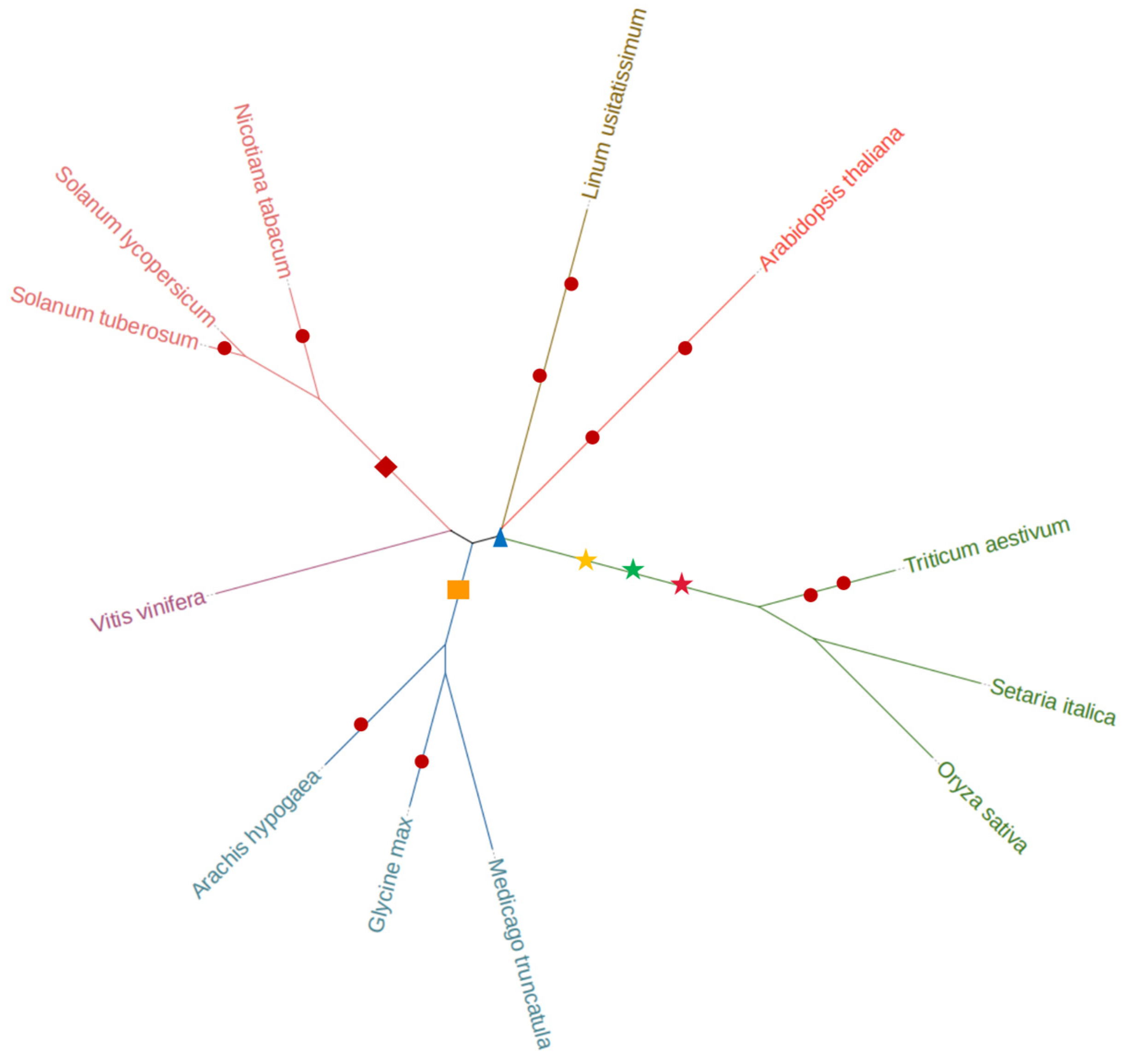
 represents members of the 3R-MYB subfamily,
represents members of the 3R-MYB subfamily,  represents members of the 4R-MYB subfamily, and
represents members of the 4R-MYB subfamily, and  represents members of the 5R-MYB subfamily (containing five conserved domains of MYB).
represents members of the 5R-MYB subfamily (containing five conserved domains of MYB).
 represents members of the 3R-MYB subfamily,
represents members of the 3R-MYB subfamily,  represents members of the 4R-MYB subfamily, and
represents members of the 4R-MYB subfamily, and  represents members of the 5R-MYB subfamily (containing five conserved domains of MYB).
represents members of the 5R-MYB subfamily (containing five conserved domains of MYB).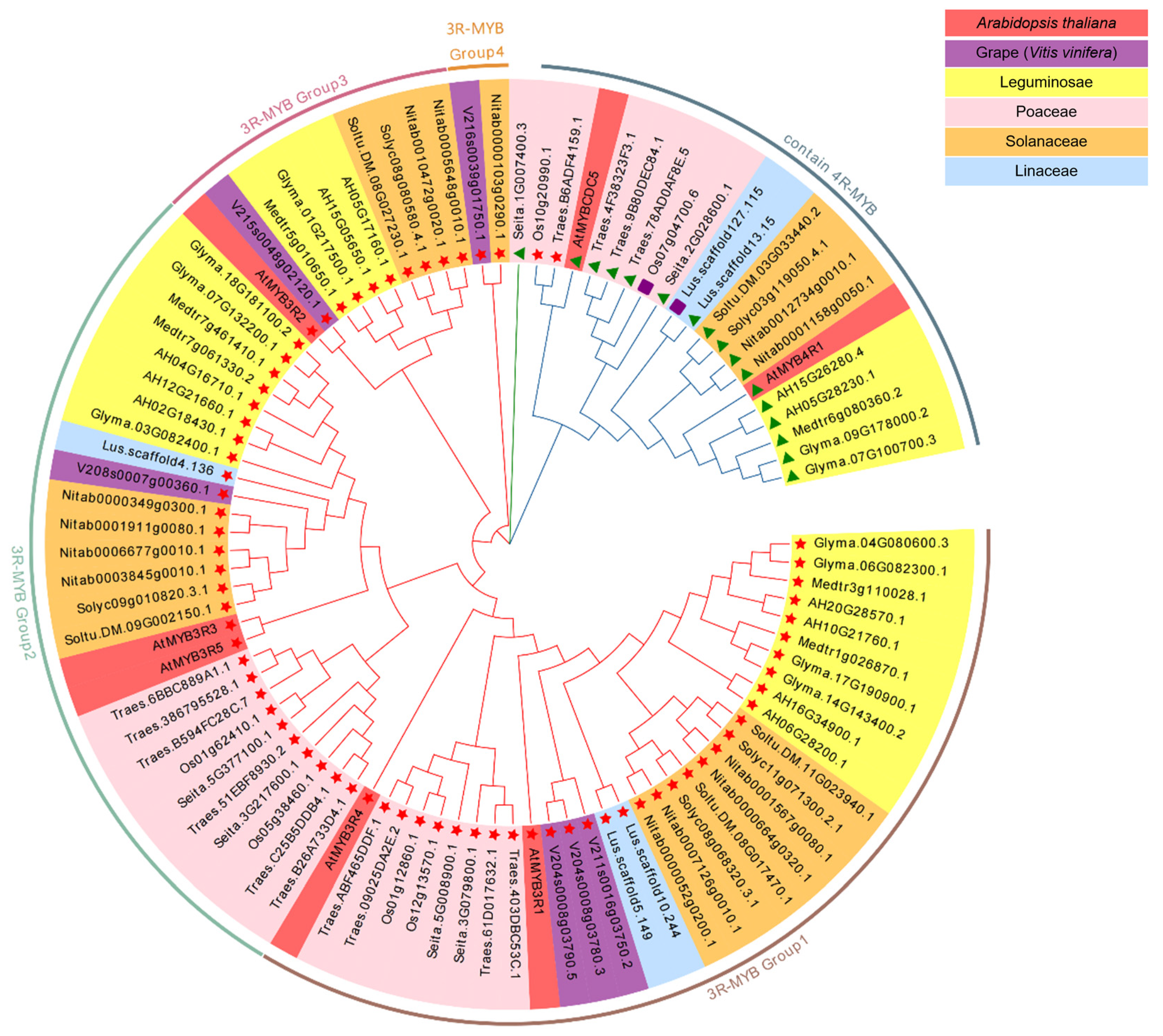
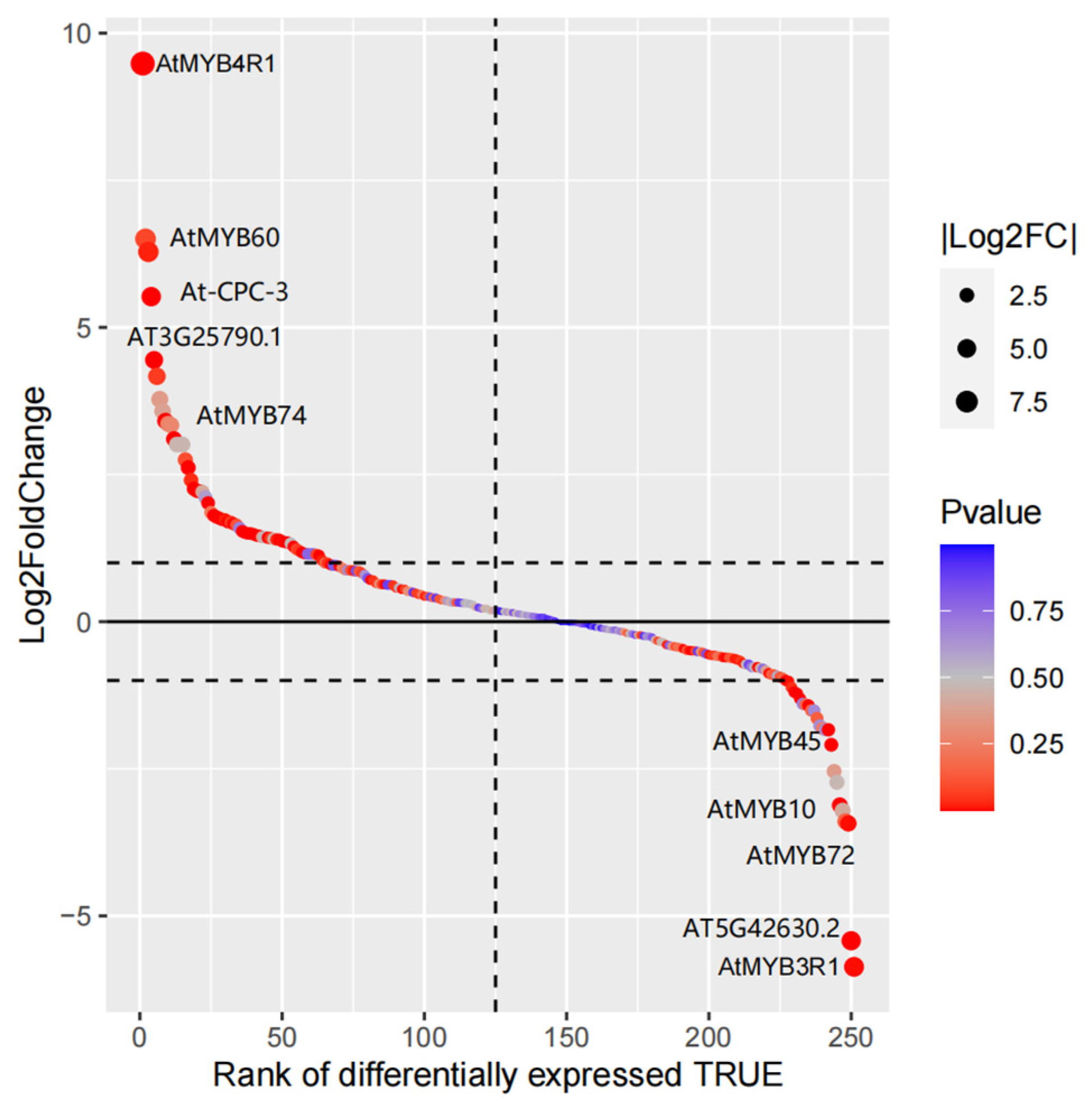
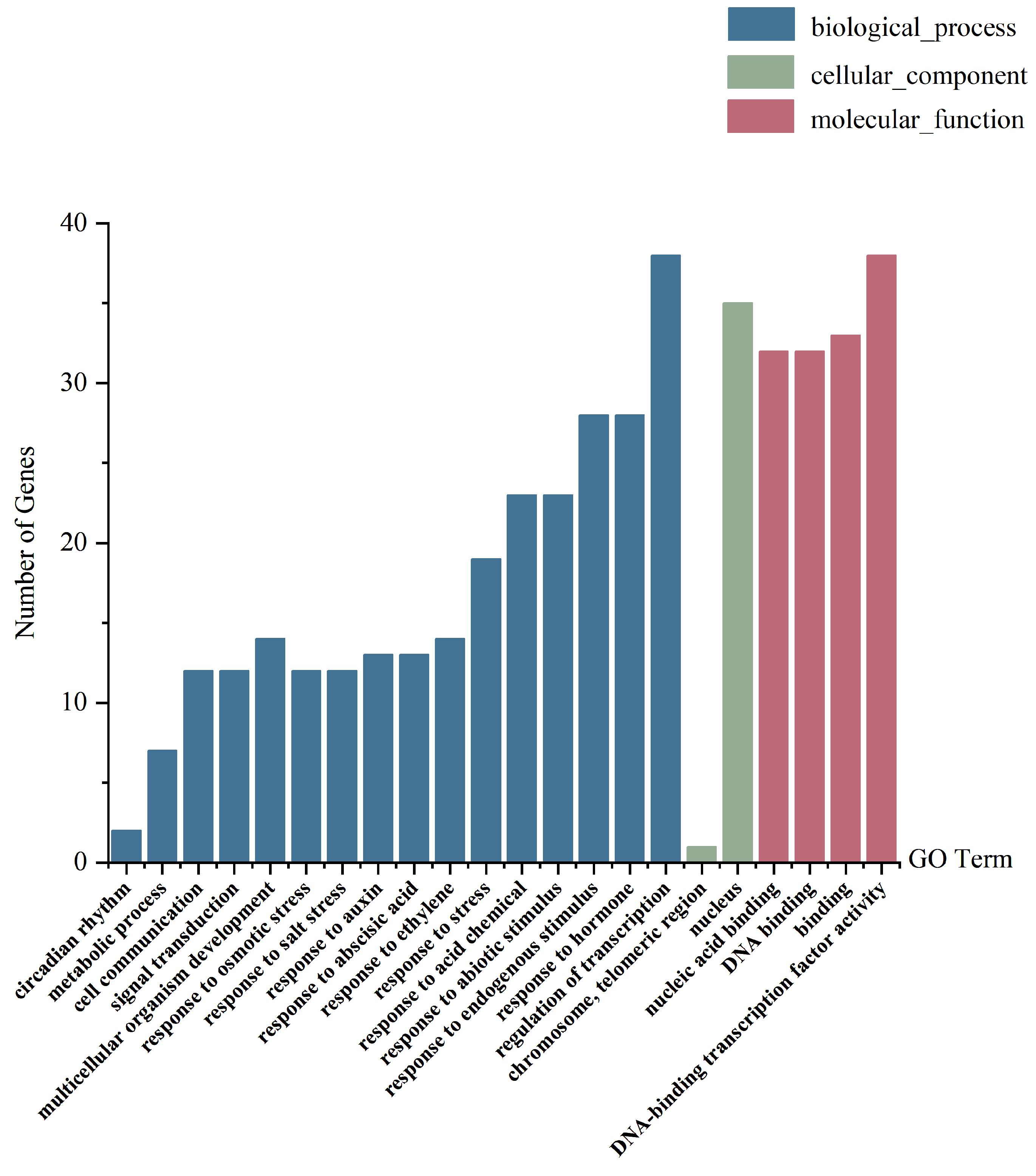


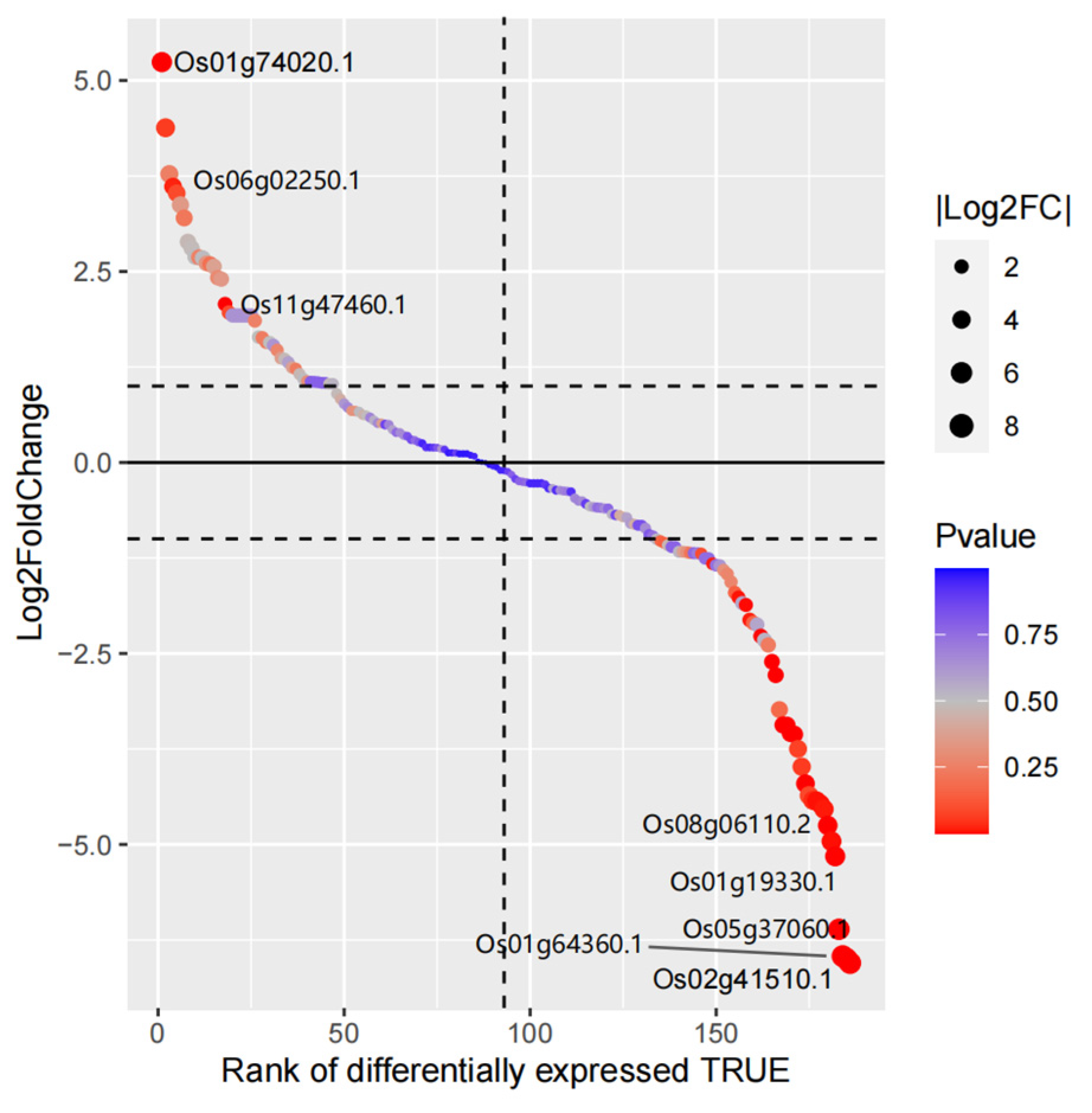
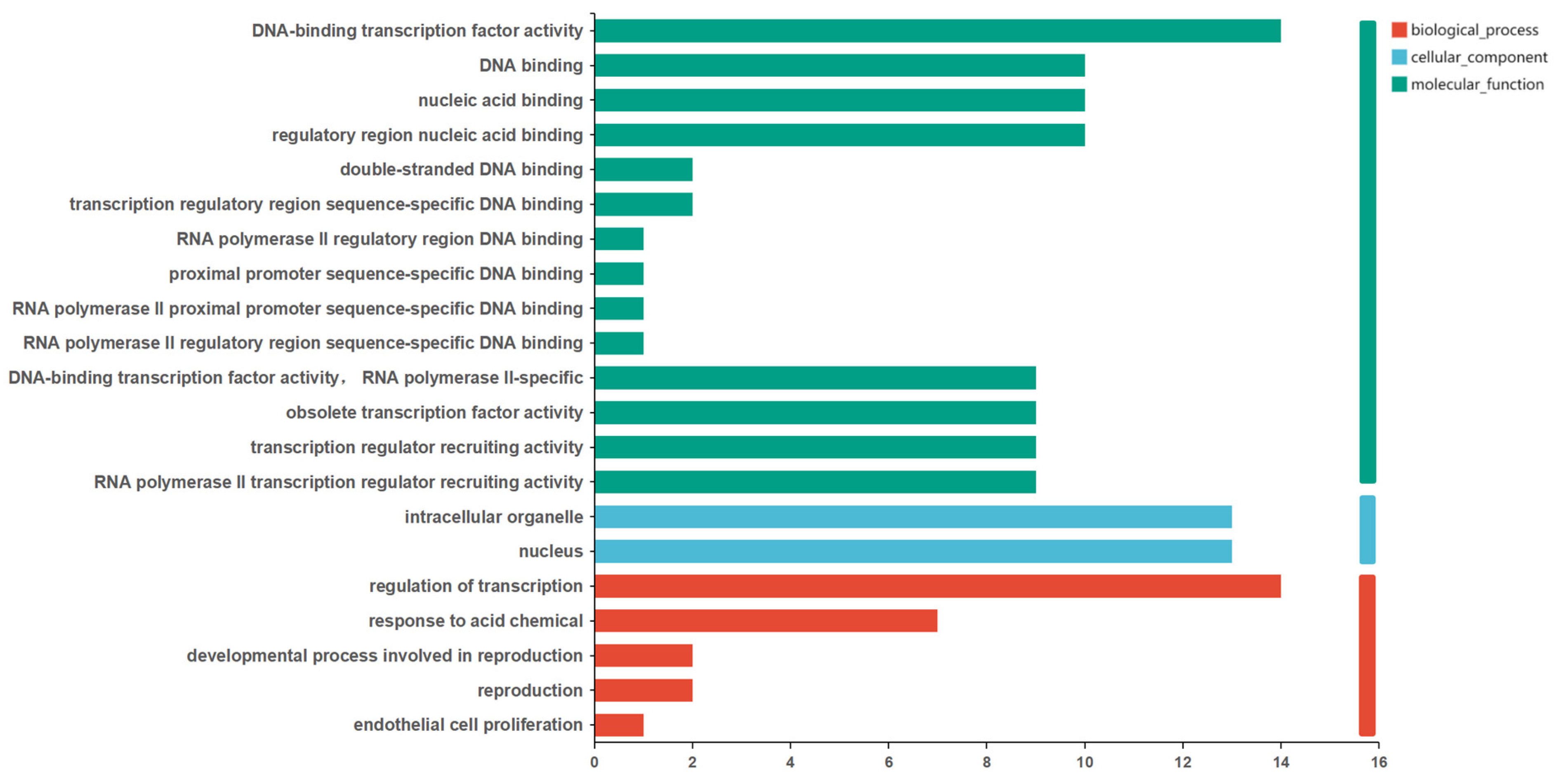
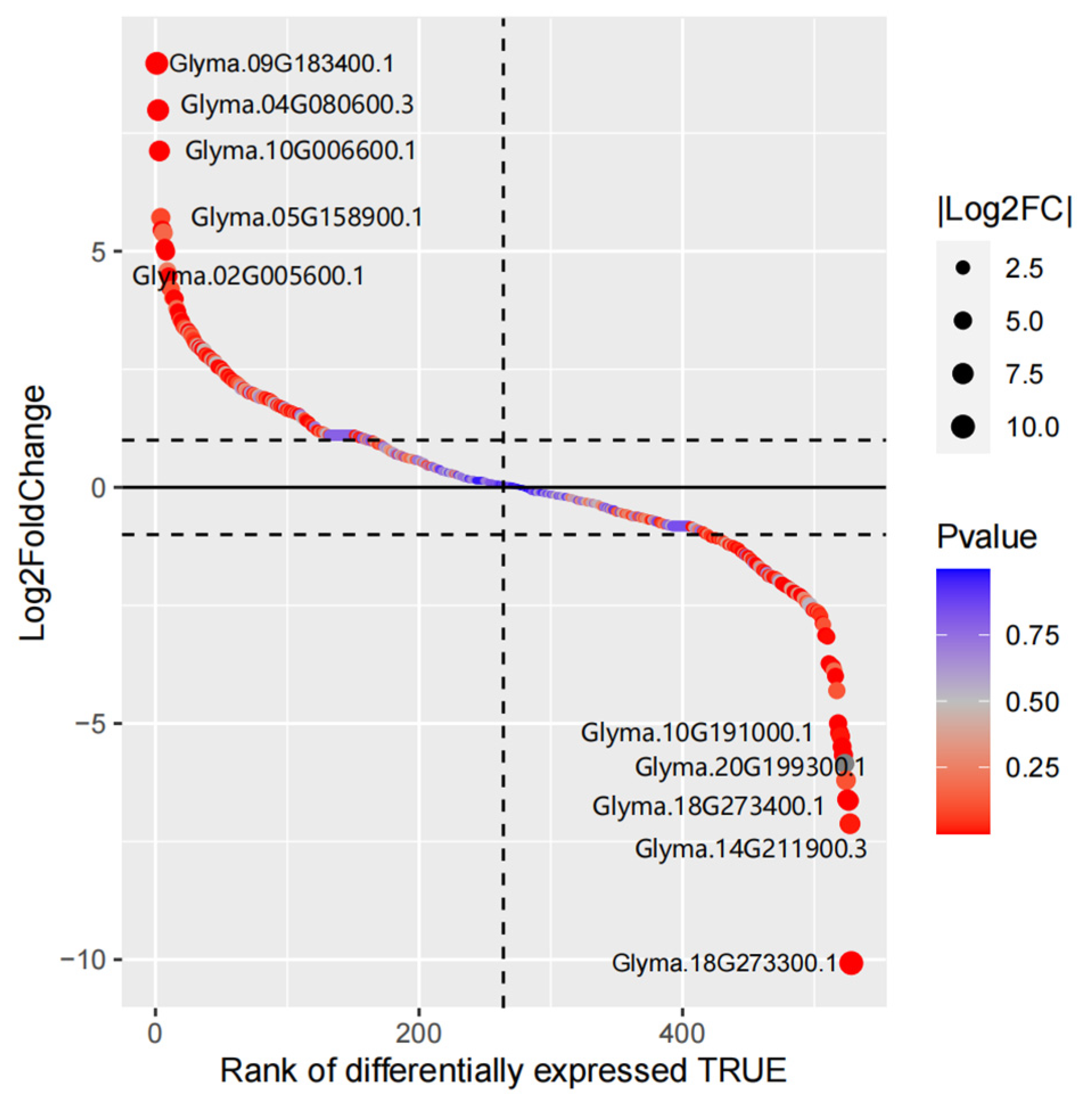
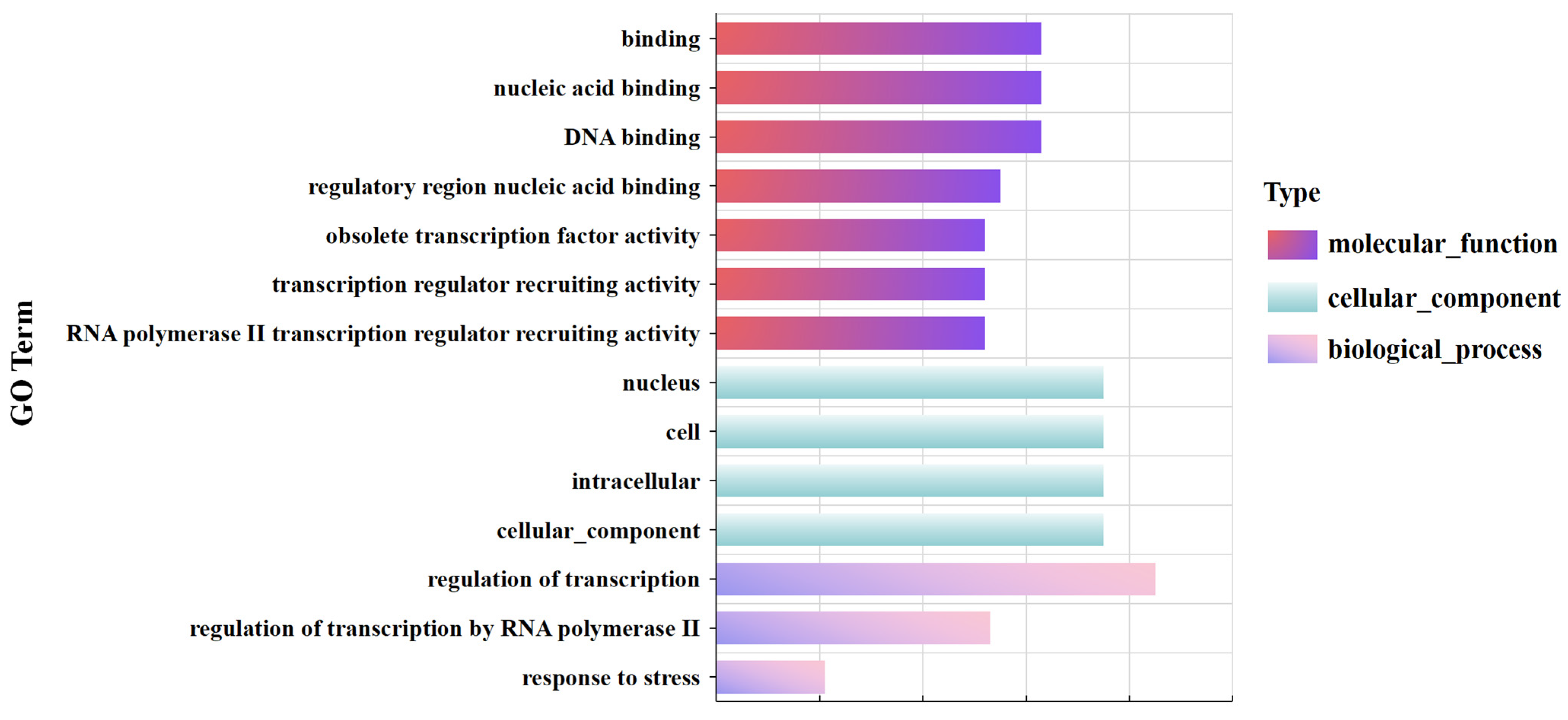
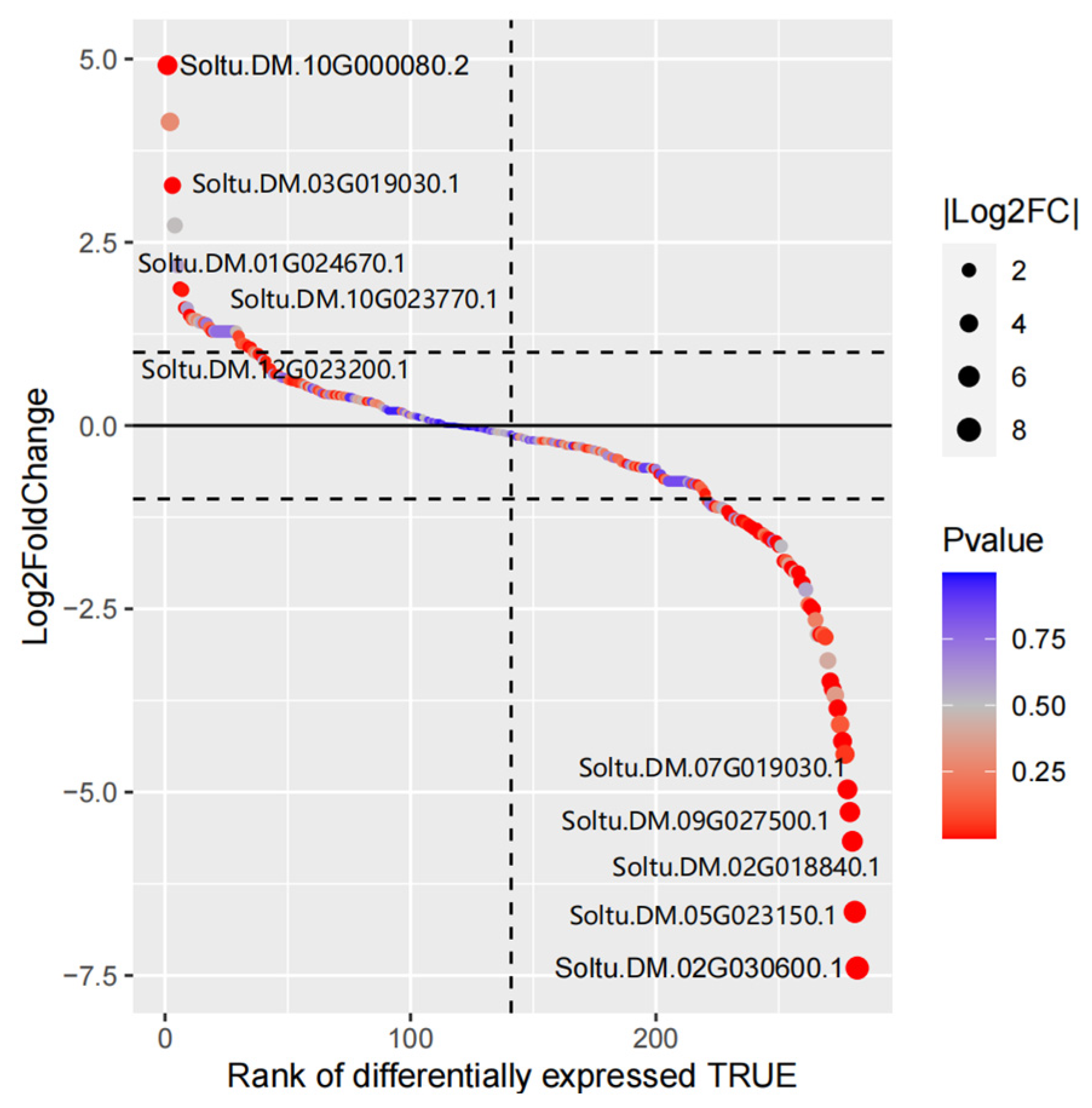
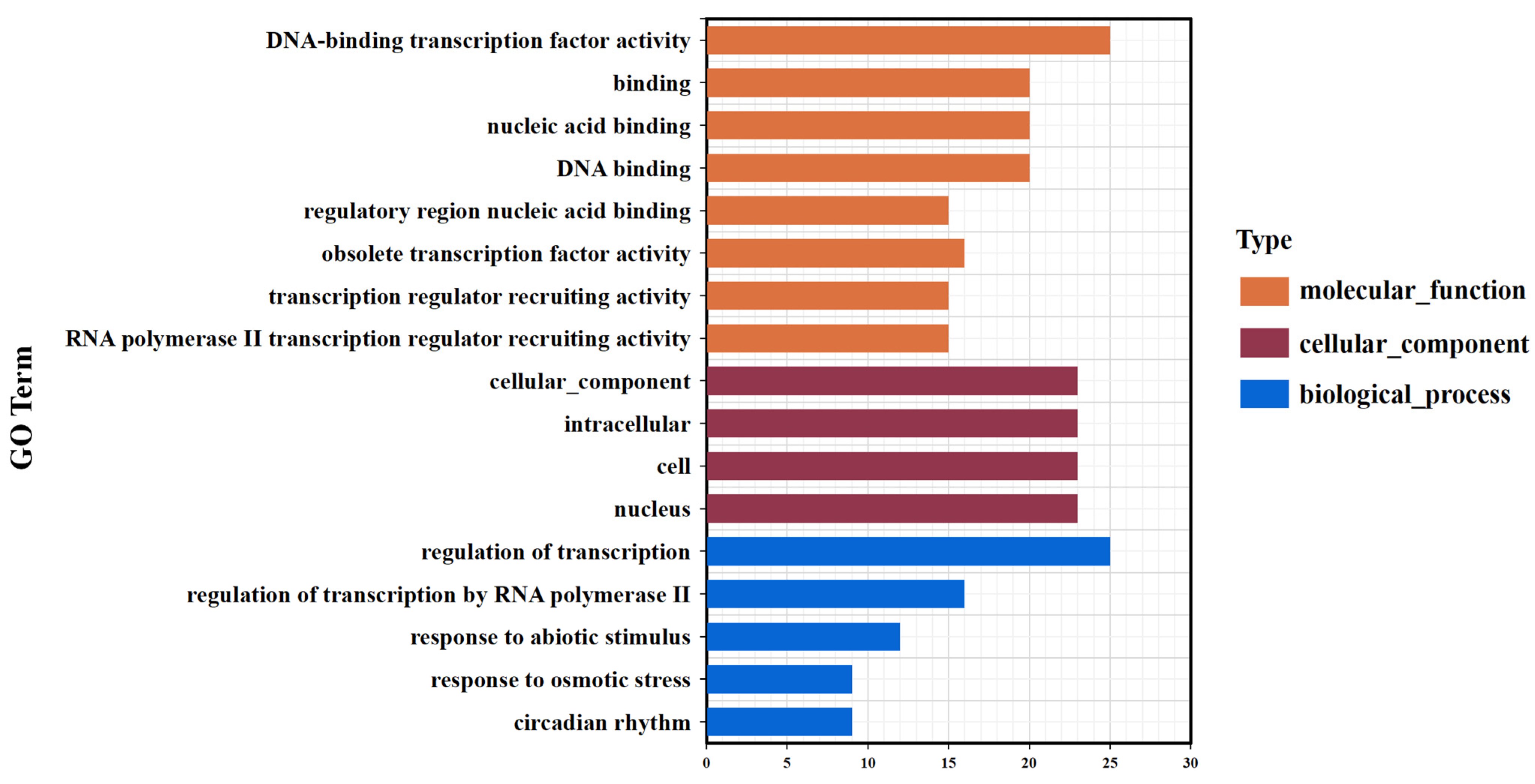
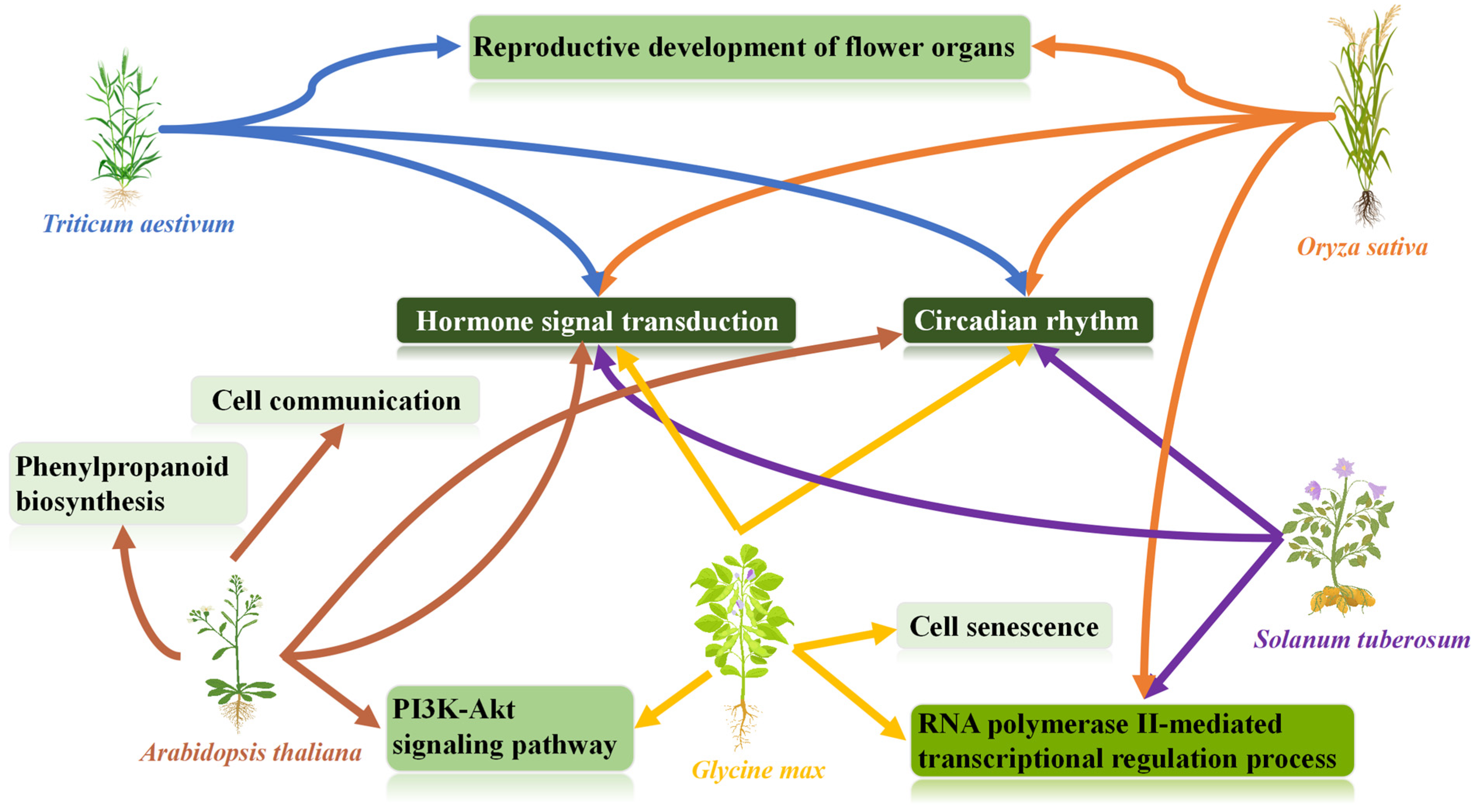
| Species | Latin Name | Database |
|---|---|---|
| Grape | Vitis vinifera L. | Phytozome v13 (https://phytozome-next.jgi.doe.gov/) |
| Wheat | Triticum aestivum L. | |
| Rice | Oryza sativa L. | |
| Millet | Setaria italica L. | |
| Tomato | Solanum lycopersicum L. | |
| Potato | Solanum tuberosum L. | |
| Soybean | Glycine max L. Merr | |
| Barrel medic | Medicago truncatula Gaertn. | |
| Tobacco | Nicotiana tabacum L. | Sol Genomics Network (https://solgenomics.net/) |
| Cultivated peanut | Arachis hypogaea L. | Peanut Genome Resource (http://peanutgr.fafu.edu.cn/index.php) |
| Flax | Linum usitatissimum L. | Figshare (https://figshare.com/articles/dataset/Annotation_files_for_Longya-10_genome/13614311) |
| Arabidopsis thaliana | Arabidopsis thaliana L. Heynh | TAIR (https://www.arabidopsis.org/) |
| Species | SRA Project Number | Drought Group Data Number | Control Group Data Number |
|---|---|---|---|
| Arabidopsis thaliana | PRJNA764209 | SRR15931251 | SRR15931262 |
| SRR15931253 | SRR15931264 | ||
| SRR15931255 | SRR15931266 | ||
| Triticum aestivum | PRJEB44859 | ERR6110517 | ERR6110415 |
| ERR6110518 | ERR6110416 | ||
| ERR6110471 | ERR6110489 | ||
| ERR6110472 | ERR6110490 | ||
| ERR6110473 | ERR6110511 | ||
| ERR6110474 | ERR6110512 | ||
| Oryza sativa | PRJNA562309 | SRR10814912 | SRR10045073 |
| SRR10814913 | SRR10045074 | ||
| SRR10814914 | SRR10045075 | ||
| Glycine max | PRJNA306380 | SRR3033500 | SRR3033503 |
| SRR3033501 | SRR3033504 | ||
| SRR3033502 | SRR3033505 | ||
| Solanum tuberosum | PRJNA874012 | SRR21209937 | SRR21209941 |
| SRR21209920 | SRR21209933 | ||
| SRR21209902 | SRR21209915 |
| Species | Total MYB | 1R-MYB | 2R-MYB | 3R-MYB | 4R-MYB |
|---|---|---|---|---|---|
| Arabidopsis thaliana | 272 | 138 | 128 | 5 | 1 |
| Vitis vinifera | 269 | 135 | 128 | 6 | 0 |
| Triticum aestivum | 608 | 357 | 237 | 11 | 3 |
| Oryza sativa | 258 | 144 | 108 | 5 | 1 * |
| Setaria italica | 285 | 157 | 122 | 4 | 2 |
| Solanum lycopersicum | 293 | 161 | 127 | 4 | 1 |
| Solanum tuberosum | 330 | 187 | 138 | 4 | 1 |
| Nicotiana tabacum | 536 | 326 | 197 | 11 | 2 |
| Glycine max | 610 | 306 | 294 | 8 | 2 |
| Arachis hypogaea | 541 | 292 | 238 | 9 | 2 |
| Medicago truncatula | 355 | 188 | 161 | 5 | 1 |
| Linum usitatissimum | 434 | 235 | 194 | 3 | 1 + 1 * |
Disclaimer/Publisher’s Note: The statements, opinions and data contained in all publications are solely those of the individual author(s) and contributor(s) and not of MDPI and/or the editor(s). MDPI and/or the editor(s) disclaim responsibility for any injury to people or property resulting from any ideas, methods, instructions or products referred to in the content. |
© 2024 by the authors. Licensee MDPI, Basel, Switzerland. This article is an open access article distributed under the terms and conditions of the Creative Commons Attribution (CC BY) license (https://creativecommons.org/licenses/by/4.0/).
Share and Cite
Zhang, F.; Ma, J.; Liu, Y.; Fang, J.; Wei, S.; Xie, R.; Han, P.; Zhao, X.; Bo, S.; Lu, Z. A Multi-Omics Analysis Revealed the Diversity of the MYB Transcription Factor Family’s Evolution and Drought Resistance Pathways. Life 2024, 14, 141. https://doi.org/10.3390/life14010141
Zhang F, Ma J, Liu Y, Fang J, Wei S, Xie R, Han P, Zhao X, Bo S, Lu Z. A Multi-Omics Analysis Revealed the Diversity of the MYB Transcription Factor Family’s Evolution and Drought Resistance Pathways. Life. 2024; 14(1):141. https://doi.org/10.3390/life14010141
Chicago/Turabian StyleZhang, Fan, Jie Ma, Ying Liu, Jing Fang, Shuli Wei, Rui Xie, Pingan Han, Xiaoqing Zhao, Suling Bo, and Zhanyuan Lu. 2024. "A Multi-Omics Analysis Revealed the Diversity of the MYB Transcription Factor Family’s Evolution and Drought Resistance Pathways" Life 14, no. 1: 141. https://doi.org/10.3390/life14010141
APA StyleZhang, F., Ma, J., Liu, Y., Fang, J., Wei, S., Xie, R., Han, P., Zhao, X., Bo, S., & Lu, Z. (2024). A Multi-Omics Analysis Revealed the Diversity of the MYB Transcription Factor Family’s Evolution and Drought Resistance Pathways. Life, 14(1), 141. https://doi.org/10.3390/life14010141






